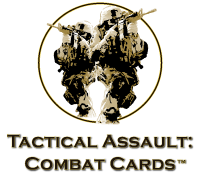Campaigns… Simple Subdivision
One topic that often comes up regarding the Combat Cards is whether they can be used to play campaign games. It is usually beneficial to first clarify what exactly is meant by a “campaign game” as there are many possible definitions. The two most commons ones are either a series of normal battles connected by scenarios, victory points, maps, a story line, etc., or a single larger battle that has key parts broken down in to sub-battles.
For the first type of campaign (connected battles), the Combat Cards work wonderfully. In fact, instructions on how set-up and run that type of campaign is given in the main rules. For the second type of campaign (the larger battle), the Combat Cards may even work better.
As the Combat Cards focus primarily on the interaction of the various types units on the battlefield rather than the specific composition of each unit, it is very easy to set up a large scale campaign. The primary change comes in how you assign what each unit represents. For example, instead of having a single figure or half-squad represent an Infantry Unit, you might label the Infantry Unit an infantry company, battalion or brigade. Instead of a single tank representing an Armored Unit, you instead label the Armored Unit a tank company or squadron, and so on. This becomes your large scale (or “big picture”) game. This game is played using the normal Combat Cards rules on a suitable size battlefield with the appropriate terrain.
The campaign aspect of the battle comes in to play when enough friendly and enemy units are together in a small enough area to make things interesting. At that point a separate battle can be broken out on another battlefield for just that smaller area. This will allow a more detailed treatment of the terrain and units involved.
Using the scalability of the rules to layout the new battlefield, you now transfer over the units involved in the sub-battle and break them down into the appropriate component parts. The infantry company from above becomes three infantry platoons (each an Infantry Unit on the new battlefield) as well as a heavy weapons platoon (a Heavy Weapons Unit), an HQ platoon (a Command Unit) and so on. This sub-battle can then be played out in its entirety, and the results conveyed back to the main battle when finished.
The main battle can then resume until another interesting smaller fight emerges, and then this is broken out into a smaller game and fought out as well. This breaking out of sub-battles can be carried out as far as you want (down to the one man/one Unit ratio if desired) and then tiered back up. The only limitation is your own imagination.
Notice too, that in all of this tiering up and down between battles, the basic rules never change – you are using the same Combat Cards core rules at every level!
Now there are still few details that have to be agreed upon prior to the start of the campaign such as how to utilize other assets from the larger game (e.g. Artillery and Aerial Units, etc.), how exactly to best convey loses back up to the larger battle, what the break down of the larger units exactly are, etc. In the future we will be publishing standardized rules for how to do that, but in the meantime most players can agree on some method of handling these things before the campaign gets rolling.
So as you can definitely see, the flexibility of the Combat Cards really afford some excellent opportunities for exploring the excitement and challenges of campaign games. And really, who doesn’t like to give their individual battles more meaning by placing them in the context of a larger battle…





